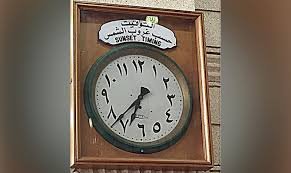Time in Saudi Arabia: A Complete Guide to Understanding KSA Time

time in saudi arabia in Saudi Arabiae is something we often take for granted—until we’re dealing with different time zones, international meetings, or travel plans. If you’ve ever found yourself googling “time in Saudi Arabia,” you’re not alone. Whether you’re planning a trip, doing business with a Saudi company, or simply curious, understanding how time works in the Kingdom of Saudi Arabia (KSA) can be surprisingly helpful.
Time in Saudi Arabia this guide, we’ll explore everything you need to know about Saudi Arabian time, from time zones and daylight saving decisions to cultural perceptions of time in Saudi society.
1. What Time Zone Is Saudi Arabia In?
Saudi Arabia is in the Arabian Standard Time (AST) zone, which is UTC+3. This means that Saudi Arabia is three hours ahead of Coordinated Universal Time (UTC).
If you’re comparing it to more familiar zones:
- It’s the same time as Moscow, Baghdad, and East Africa.
- It’s one hour ahead of South Africa and most of Eastern Europe during the winter.
- It’s two hours ahead of Central European Time (CET) and three hours ahead of the UK when daylight saving is not in effect there.
Time in Saudi Arabia follows this time consistently throughout the year. Unlike many countries, it doesn’t switch clocks during different seasons.
No Daylight Saving Time
One key fact: Saudi Arabia does not observe Daylight Saving Time (DST). While many Western nations spring forward and fall back, KSA time stays fixed year-round at UTC+3. This has made scheduling easier for locals and businesses because there’s no biannual shift in time.
This consistency is particularly helpful for travelers, especially those coming from DST-observing countries who often find it confusing to track time differences. So if you’re flying in from Europe or the US, remember that Saudi time won’t shift—it’s your home country’s time that might change seasonally.

2. How Time Is Perceived in Saudi Culture
time in saudi arabia the literal time in Saudi Arabia is one thing—but understanding how time is perceived culturally is another layer you shouldn’t overlook.
In Saudi culture, time is viewed more flexibly and relationally compared to the Western emphasis on punctuality and rigid scheduling. This doesn’t mean that Saudis don’t value time; rather, it’s shaped by tradition, hospitality, and priorities that differ from Western business norms.
Time in Social Settings
Time in Saudi Arabian personal and family settings, time can be fluid. Social events, gatherings, and meals might start later than planned and extend far longer than scheduled. The emphasis is on the experience, not the clock. You might get invited for dinner at 8 PM and not eat until 10 PM—but that’s perfectly normal in Saudi culture.
- This isn’t to say people are lazy or unproductive—it’s just a different rhythm of life. Prioritizing relationships over punctuality often leads to deep, meaningful connections, which are central to Saudi social life.
Time in Business and Work Ebusiness, especially with international partners, punctuality is more respected. Meetings usually start on time, and there is growing attention to deadlines and schedules. That said, there’s still more room for negotiation and flexibility compared to some Western work environments.
When dealing with Saudi companies, patience and adaptability are valuable. Emails might take a bit longer to get responses, and schedules might shift. Building trust is key, and often, once that relationship is solidified, the workflow becomes much smoother.
3. Prayer Times: A Unique Aspect of Saudi Time Structure
One of the most fascinating elements of time in Saudi Arabia is how it intertwines with Islamic prayer times.
Saudi Arabia is the birthplace of Islam, and religion plays a major role in daily life. Muslims pray five times a day, and in Saudi Arabia, these prayer times significantly influence the daily schedule of businesses, schools, and even shopping centers.
How Prayer Times Affect Daily Life
The five prayer times—Fajr (dawn), Dhuhr (midday), Asr (afternoon), Maghrib (sunset), and Isha (evening)—are not fixed by the clock. Instead, they change slightly each day based on the sun’s position.
In Saudi Arabia, during each prayer time, many businesses temporarily close for around 20–30 minutes to allow staff and customers to perform prayers. This is particularly noticeable in markets, restaurants, and shopping malls.
So if you’re planning errands or meetings in Saudi Arabia, it’s helpful to check the local prayer schedule. It’s widely available online and even built into many local apps.
4. Time Differences When Traveling to Saudi Arabia
If you’re planning a trip to Saudi Arabia, knowing the time difference from your home country is crucial for managing jet lag, booking hotels, and syncing plans.
Here’s a quick glance at common time differences:
- From New York (Eastern Time): KSA is 8 hours ahead
- From London (GMT): KSA is 3 hours ahead
- From India (IST): KSA is 2.5 hours behind
- From Sydney (AEST): KSA is 7 hours behind
Flights to and from Saudi Arabia often operate late at night or early in the morning due to the region’s preference for cooler travel times—especially in summer when daytime temperatures soar. So it’s always a good idea to double-check your arrival time in local Saudi time to avoid confusion.
Adjusting Your Body Clock
If you’re flying in from far away, give yourself a day or two to adjust. Hydrate well, get sunlight during the day, and try not to nap excessively when you land. This can help you get on “Saudi time” much faster and enjoy your trip more comfortably.
5. Digital Timekeeping in Saudi Arabia
Like anywhere else, modern Saudi life relies heavily on digital timekeeping. Smartphones, smartwatches, and computers all automatically sync to the Arabian Standard Time zone.
Whether you’re using Android, iPhone, or even a basic digital watch, your device will display the correct Saudi time once it updates to the local network or GPS.
Local Time Apps and Platforms
There are several apps that help with local Saudi time and scheduling:
- Tawakkalna – For health and travel in Saudi Arabia
- Athaan apps – Notify you of accurate prayer times based on your location
- Google Maps & Waze – Offer local traffic time estimates in real-time
Also, websites like timeanddate.com or worldtimebuddy.com let you convert time between cities easily, which is helpful for international travelers and remote workers.

6. Future of Time in Saudi Arabia: Any Changes Ahead?
For now, Saudi Arabia shows no sign of adopting daylight saving time. The fixed UTC+3 schedule works well for most of the population and aligns with the needs of both local life and international business.
As the country continues its Vision 2030 modernization plan, we might see changes in how the workday is structured or how time is managed in terms of productivity—but the actual time zone itself will likely remain the same.
Some Saudi companies are experimenting with hybrid working hours, and schools are embracing digital scheduling tools, especially after the impact of COVID-19. These shifts may influence how strictly or loosely time is adhered to in various sectors of society.
Final Thoughts
Whether you’re visiting, working with Saudis, or just curious about global time zones, Saudi Arabia offers a fascinating look into how time can be both precise and flexible at once.
Next time someone asks you, “What time is it in Saudi Arabia?”, you’ll know it’s not just UTC+3—



